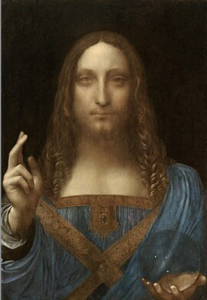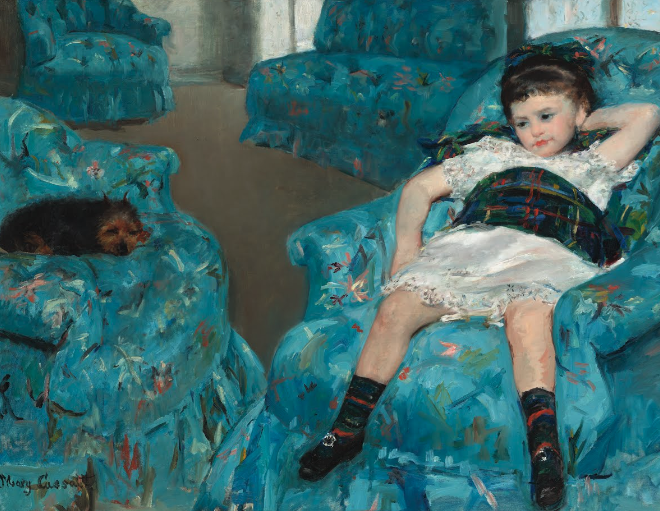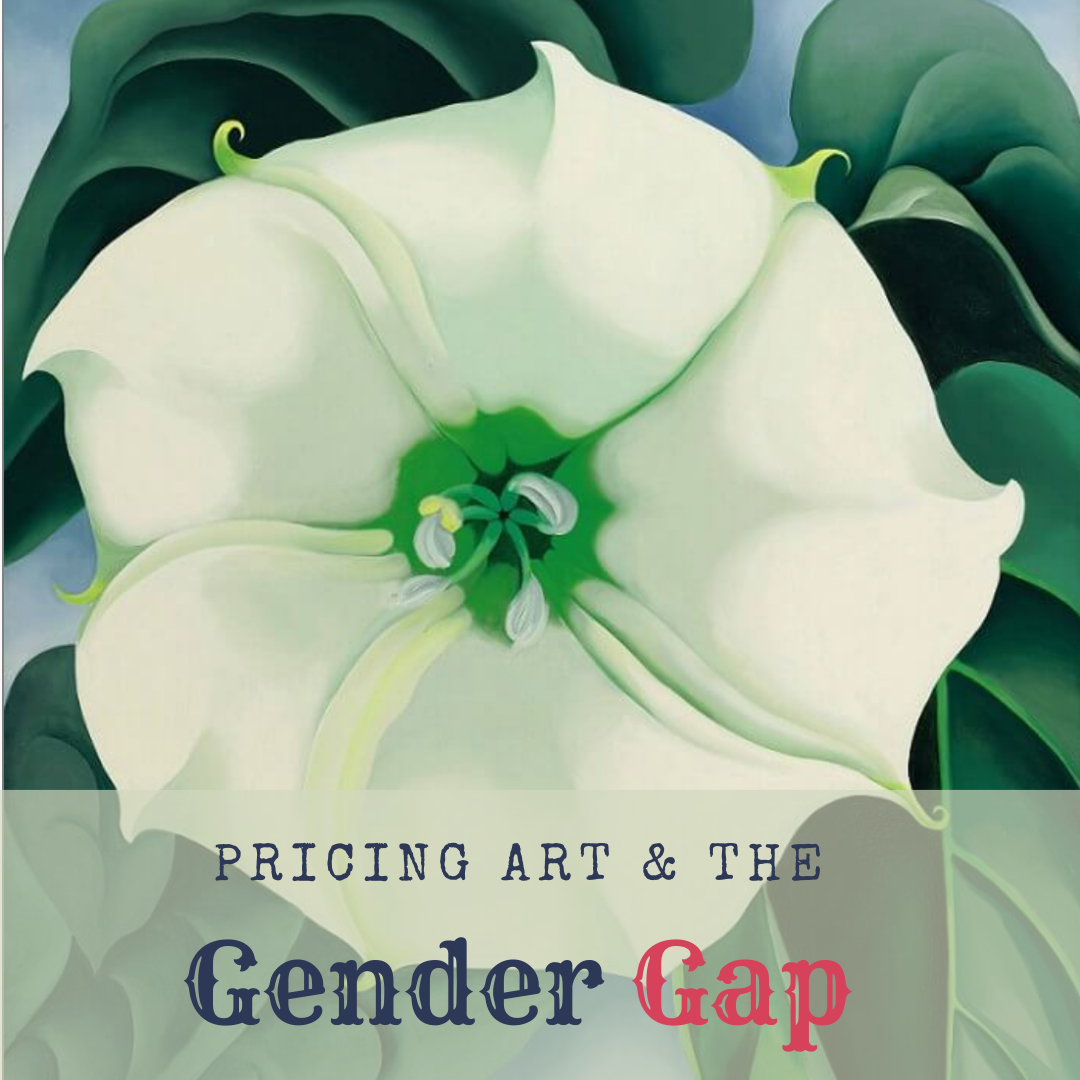I’ve written about how art is priced in the blog Making Sense of the Price of Art, but the gender gap in pricing is a bit more nuanced. And, yes, it’s still a thing.
Let’s dive in.
The Numbers Don't Lie
According to an article published in Forbes, Aug 2022, titled “The $192 Billion Gender Gap in Art,” of the $196.6 billion spent at art auctions between 2008 and 2019, work produced by women accounted for only $4 billion, or around 2% of the total sales.
At auction, the gap is quite striking. Consider the $450 million paid at auction for Leonardo da Vinci’s “Salvator Mundi” compared to the record for a female artist–less than 10% of that value–$44.4 million for Georgia O’Keeffe’s “Jimson Weed/White Flower No. 1.”

How about sales for living artists? Here Jeff Koons holds the record of $91 million for “Rabbit.” The closest woman: Jenny Saville’s “Propped” went for $12.4 million; that’s 14% of what the Koons went for.

Of course, historically women weren’t allowed to make art as anything beyond a polite distraction, with the exception of such trailblazers as Camile Claudel (1864-1943), Rosa Bonhuer (1822-1899), and Artemisia Gentileschi (1593-1952/53). And for many female artists such as Mary Cassatt (1844-1926), access to subject matter as well as the freedom to have a career outside the home was strictly dictated and often forbidden. Thus the dearth of women artists.
How Women& Their PRices Prices Stack Up, A Snapshot
Forbes analysts also found these fun facts:
- Art by women sells for 42% less then men. (See “Gendered Prices” from Oxford Academy.)
- Phos One‘s analysis of 18 major museums shows 87% of collections are make and 85% are white.
- According to research by Helen Gorrill in “Women Can’t Paint: Gender, the Glass Ceiling and Values in Contemporary Art,” when men sign a work of art, it increases in value; however, when women sign their work, it decreases in value.
- Mary Ann Sieghart on BBC Sound in the episode, “Recalculating Art,” uncovers many truths like the research that people can’t tell if something was painted by a man or woman, however, people preferred paintings attributed to a man, whether they were painted by a man, woman or AI. Further, she notes that in Gombrich’s “The Story of Art,” a book used as a textbook for college students, only one female artist is mentioned.
- 70% of students in art school are women, and yet, in the art world, this is reversed when it comes to validation of an artist: 70% of artists in galleries and, thus, work in collections and awards go to men.
The Pricing Conundrum: Western Auctions
OK, apply all the above to non-blue chip women and it’s more the same. Here’s where it gets personal.
A friend of mine had been asked to take part in a Western themed auction held annually in Wyoming. She created a painting for the auction–a truly wonderful piece that pushed her out of her comfort zone–but when she went to price that painting, she faltered.
Was she, she wondered, undervaluing herself and her work once again?
There are layers to this pricing conundrum.
First and foremost, auctions are not usually kind to living artists, man or woman. Here’s why.
When art goes into an auction, the auction house starts bidding well below retail, often half. The thinking is that a good auctioneer can whip the crowd into a frenzy, pitting bidders against each other. If the auctioneer can get several people to dig in their heels, game on. The key is “several” bidders have to want the art. Oh, and at least two interested bidders need to show up. That means the weather needs to cooperate or their internet needs to be working or they have to remember the auction is happening and they can’t get sick or have any kind of emergency that calls them away. Lots of ifs….
Let’s say all that happens, the artist is still put in the crappy position of seeing their work open at 50% of retail, because retail pricing doesn’t encourage competition since buyers can, auction houses insist, buy art anywhere at retail, so what’s the fun in that?
For artists, it’s only fun when their work goes for a price over retail. Otherwise, auctions are purely an anxiety-ridden experience that does nothing more than shave precious years off the artist’s life.
The Rules Apply
For some reason, the Western US market for Realism treats art sales like cattle at a live stock auction. Auctions are the antithesis of high-brow East Coast sales where people dress in Dior and talk in hushed tones while sipping champagne. No, Western Art auctions are ruckus affairs straight out of a wild west show. Instead of cowboys getting trampled, however, we stand back and watch our artists get thrown.
Personally, I don’t understand it and have avoided working on auctions at all costs. But when it’s part of the milieu, what can you do but play along?
My friend knows all this and still she asked me what I thought might happen if she raised her prices for the upcoming auction, the one where she’d plan to submit that killer new work. treats
The thing is, she wasn’t thinking of just upping her prices; she was thinking of doubling them to align her retail with that of the men in the auction.
Keeping an Open Mind
I listened carefully as my friend laid out her reasoning, but I knew this was a bad idea.
In a nutshell, she agued the following:
1. She’d been painting as long as many of the artists in the show, thought not as long as most.
2. Her prices were, compared to her peers, half that of the men.
3. She always sold well at this particular auction.
4. She would be featured that year in a pre-auction collector get-together, so she’d be getting a little more attention on her work.
5. She’d heard whispers that some artists increased their prices for auctions and major shows, so why was she the only one following the rules?
But double?
“I started thinking,” she said, “men were inflating their prices for the auction. So I went through past show catalogues and looked at prices, it looked like that was the case. And I thought, ‘are you fucking kidding me?’ And they’re getting it, the work is selling at those prices.”
Then she went to gallery websites and saw they actually hadn’t inflated their prices for the auction; that the men were indeed getting higher prices than the women.
“The veil was lifted; I felt this huge gap,” she confided. “There are 16 women and 86 men in that auction. I spent a little time going back to see where women’s work was priced and I do think, overall, we do price at a lower threshold, despite having similar credentials.”
In this sense, if she doubled her price for the auction, she’d still be well within the range of the other works for sale.
Pricing: A Double Edged Sword
My advice:
Do not double your price for this one painting in this one event.
Why:
Collectors do their homework. They will look up your prices–just like my artist friend did when comparing her work to her peers. They will see you put an unreasonable price on that one painting and will pass.
But if it’s a great painting, isn’t it worth more?
Nope. Not when you’re a living artist who is still actively making art. I’ve stated this before, but it bears repeating: Artists are poor judges of their work. They feel like they accomplished something, and they probably did, but in the grand scheme of things, the accomplishment may be relatively minor. Or it may be monumental but collectors rarely see or know this has happened. What collectors see is that an artist has raised their prices too high, too quickly. Collectors may stick with an artist, calculating the increased value in the work they currently own, but they often won’t buy more. In fact, the collectors who watch the market may be considering selling that work and trading up for something else.
The Race Is Won By the Sure & Steady
Despite the fact that several artists did pad their prices, she hung with the majority who kept to their retail across the board. She did take a small price increase, but planned to do so anyway–she takes a 5-10% increase every January.
“You have to look at this through a bigger lens,” she said, of her decision. Once her price was determined, the bigger issue was then, where to start the reserve, which artists were given the opportunity to increase.
“What will be the lasting impression,” she wondered, when thinking through the ramifications of changing the reserve, “from a collector’s experience, if they see your work go for half the retail? But consider being the artist whose painting goes for $3,000 over. That leaves the collector watching and thinking, ‘this isn’t an artist who has shot the moon; I should get in there and buy her work.'”
The director of the auction, in a preliminary conversation leading up the event, mentioned that she thought her price increase was smart, and that they were getting a lot of good feedback on her work. Yet, she was still feeling unnerved.
“I was feeling gender gap issues and what the numbers seemed to be doing in my head,” she said. “After our conversation, it helped me think about how to position myself in a good way.”
She went on to express her frustrations with the whole Western market and auction system.
“Big picture, there’s something about the auction; it’s a nerve-wracking experience,” she said. “I feel a lot more “good old boy’s club” at these traditional shows. I painted to a scene that, for me, feels more masculine. For the first time, I depicted an historic “comment” on the western world. I love the painting but every time I see it it feels like I painted one of the boys’ paintings as a woman. I even questioned that if they didn’t know it was me–a woman–how would it sell?”
Though she believes these are merely her own insecurities, she recalled being at a show and talking to a group of women. “One of the gals was looking through the roster and said, ‘Oh, my god! Where are the women?'”
Back to Square One
As women’s voices grow stronger and they take on work and subject matter that is vital and compelling, the question of parity remains. I asked her why she believed men in the Western art/Realism market command higher prices?
“A man’s stance on the West is the cowboy because that’s what men did. A bunch of women on a cattle drive, that didn’t exist. A woman’s experience is more of place and home. Yes, there are modern cowgirls but the glamorous roles were male,” she said, and added, “That’s one of the reasons why I paint the landscape; there is a sense of place that holds many stories and doesn’t differentiate between gender.”
Maybe the bigger question is: why do women feel the need to compete with this subject matter in the first place? Maybe this is part of the gender-gap in pricing; we’ve come to believe the stereotypes and women don’t fit in them neatly. In fact, women don’t fit the stereotype of artist as professional and so are treated as if they are working at a nice hobby. But when a man enters into that world it’s like, ‘Oh, what are you doing?’ His work and choice of career lands differently.
And yet the vicious circle spins: The majority of art we see is by men; it’s familiar; we studied it and were taught it’s importance and value. If collectors don’t understand the worth of a woman’s work–because the market doesn’t support that at sales and auctions–how can women ever break through?
“The cowboy and Indians, horses, tipis, white men painting Native Americans,” she said, “really bothers me. These are depictions of things that happened in the 1880s. But they still get gobbled up.”
Post Auction Blues
I heard from my friend in a text she sent from the road as she was headed home from the auction weekend. It did not go well. Her painting went for under the reserve; she was devastated. In the weeks since, my friend looked back a bit more wistfully. “I’m proud to be one of the female voices; it’s really important that we are in there. If we all bail, that doesn’t help us. I am part of that movement, that presence. We need that counter-voice.”
As for the sale, she also heard from the organizers, who were roundly disappointed in the sale, that no one did well. Perhaps, I mused, it’s time they rethink their structure and motivation, maybe start listening to the artists?
The numbers went like this:
103 paintings and sculpture
16 women and 87 men
20% of the art went for asking or above
43% sold for 75% of asking or lower
12% were bought-in (unsold because they didn’t meet reserve)
The day after the auction there is a quick draw. My friend didn’t participate this year, but related the story of what happened in a previous year.
Artists set up in a crowded plaza to paint while spectators mill about asking questions and making comments on the work. After the allotted time runs out, the artists set down their brushes and their paintings are judged, someone wins a prize, then the artists are told to line up and parade their work, when called, before the audience who gets to, once again, bid.
“I fucking killed it,” she said of her on-the-spot painting. “I represented myself very strongly.” The guy who won the Quick Draw, she told me, did a small sketch painting. “Something about the way the auctioneer worked the crowd didn’t sit well with me. He put his arm around that young guy and they were laughing and joking; he was the favorite, I guess. It just felt that way. It wasn’t cool.”
Please feel free to share my blog with anyone who would benefit from it. And if you have a topic you’d like me to explore, please leave a comment below. Thanks for reading! If you haven’t already subscribed, please do so HERE.

7 thoughts on “Pricing Art: The Gender Gap”